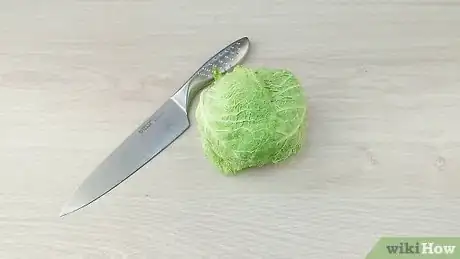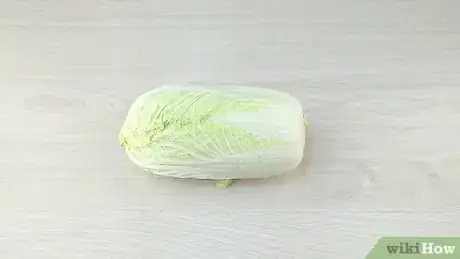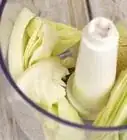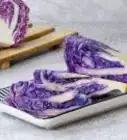wikiHow is a “wiki,” similar to Wikipedia, which means that many of our articles are co-written by multiple authors. To create this article, 13 people, some anonymous, worked to edit and improve it over time.
The wikiHow Video Team also followed the article's instructions and verified that they work.
This article has been viewed 183,500 times.
Learn more...
From salads to soups, coleslaw to curries, cabbage can be an essential part of many great dishes. A whole head of cabbage can be a little intimidating sitting in your fridge, but fear not: cutting it for use is a quick and simple task.
Steps
Cutting Round Cabbages
-
1Remove damaged outer leaves. Only remove leaves that are brown, slimy, or pocked with holes. The remaining outer leaves are often tough, but this shouldn't be an issue after cooking.
-
2Rinse and dry the cabbage. Hold the cabbage under cool, running water. Rub the cabbage with clean fingers to remove dirt, germs, and pesticides. Pat dry with a paper towel.Advertisement
-
3Select a long, stainless steel knife. Chopping will go much faster if the knife is longer than the width of the cabbage. Avoid carbon steel knives, which will turn the cut edges black.
-
4Cut the cabbage in quarters over a stable cutting board. Hold the cabbage firmly against the cutting board, spreading your fingers over the side of the cabbage. Cut through the center of the cabbage in one motion.
- If you see worm holes or other signs of pests, soak the cabbage in salt water for 20 minutes before you continue.[1]
-
5Remove the white core. Any spherical cabbage (green, red, or Savoy) contains a tough, white stem unpleasant to eat. To remove it from each quarter of the cabbage, hold the piece vertically, with the V-shaped core at the base. Slice off the core in one diagonal cut. You don't need to cut deeply into the cabbage to remove this.
- If you're making wedges, leave a thin white layer to hold the leaves together. You can leave the cabbage in quarters, or cut each one in half to make eight smaller wedges.
-
6Slice or shred the cabbage (optional). Place a cabbage wedge flat on the cutting board. Bend your fingers inward and hold the wedge in place, so your knuckles are closer to the knife blade than your fingertips. Slice the cabbage through the outer leaves to the center. Cut in ¼ to ½" (6 to 12 mm) slices for stews, or shred to ⅛" (3 mm) thickness for sauerkraut or slaw.[2]
- You can also shred with a mandoline slicer, a grater with large holes, or a food processor's grating disk. Mandoline blades can be dangerous to inexperienced users, so select a model with a hand guard.[3]
- You can slice across the wedge for short slices, or along the wedge for longer ones. Either way is fine for any recipe.
-
7Cook or treat with lemon juice. For longest fridge life, leave cabbage whole until you plan to use it. If you have more than you can cook in one sitting, rub a lemon along the cut surface to prevent browning. Store in plastic wrap or an unsealed plastic bag, refrigerated, for up to two weeks.
- Store shredded cabbage in a bowl, under cold water with a squeeze of lemon juice. Cover in plastic wrap and refrigerate.
Cutting Long Cabbages
-
1Identify the cabbage. Chinese cabbage is a long, cylindrical vegetable that comes in two types. These requires slightly different approaches:
- Napa cabbage looks similar to a head of Romaine lettuce, with thin, tightly packed leaves.[4]
- Bok choy has a long, thick white stem with several branches. The leaves are dark green and clustered at one end.
-
2Prep the cabbage. Rinse the cabbage and remove any wilted leaves. If cutting bok choy, chop off and discard a small chunk from the base. This brownish area where the stem branches meet tends to be tough and unpleasant.
- You do not need to chop the base off Napa cabbage.
-
3Halve the cabbage lengthwise. Whichever variety you are using, place the cabbage on a stable cutting board. Cut the cabbage through the center of the stem with a large, stainless steel knife.
- Avoid carbon steel knives, which can leave black marks on the cabbage.
-
4Hold a half in place with the claw position. When chopping any vegetable, the "claw" position will protect your fingers from cuts. Curl your fingertips inward, so your knuckles are nearest the knife blade.
-
5Slice across the leaves and stem. Cut across the width of each half to make cabbage pieces as thin or thick as you desire. Thin shreds of ⅛" (3 mm) are ideal for coleslaw or sauerkraut, but thicker slices are fine for soups, or if you have a dull knife.
- Both the stem and leaves of napa cabbage and bok choy are edible.
-
6Cut bok choy leaves (optional). Some heads of bok choy have large, wide leaves. Cut these into more manageable pieces by slicing through the pile of leaves once or twice lengthwise.[5]
- The bok choy leaves may require less cooking time than the stems. Consider adding them 5–10 minutes after you start the stems.
References
- ↑ http://www.recipetips.com/kitchen-tips/t--819/all-about-cabbage.asp
- ↑ http://www.thekitchn.com/how-to-shred-cabbage-cooking-lessons-from-the-kitchn-200954
- ↑ http://www.finecooking.com/videos/how-to-use-mandoline.aspx
- ↑ http://startcooking.com/how-to-cut-cabbage
- ↑ http://www.hippressurecooking.com/clean-cut-and-pressure-cook-bok-choi/
- ↑ http://startcooking.com/how-to-cut-cabbage
- ↑ http://startcooking.com/how-to-cut-cabbage
- ↑ https://experiencelife.com/article/bok-choy/
About This Article
Before cutting a cabbage, remove any wilted or damaged outer leaves and rinse the head of cabbage under cool, running water. If the cabbage is round, cut it into wedge-shaped quarters with a long, stainless steel knife. Make a diagonal cut to remove the hard stem and core from the base of each of the wedges. If you like, use a knife or mandoline to cut the quarters into thin shreds. If you’re cutting up a long cabbage, such as a napa cabbage or bok choy, cut the cabbage head in half lengthwise, then make several cuts widthwise across each half. As you do this, lay the cabbage cut-side-down on your cutting board and brace it with your non-dominant hand, but keep your fingers curled under so you don’t accidentally cut them with the knife. If there’s any part of the cabbage you don’t want to use right away, rub the cut edges with lemon juice to help it stay fresh longer in the fridge. If you want to learn how to preserve your cabbage so it lasts longer after it's cut, keep reading the article!


















































